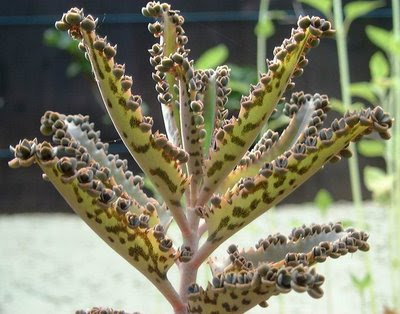 |
| The 'Devil's Backbone' - Kalanchoe daigremontiana |
The 'Devil's Backbone' - Kalanchoe daigremontiana, is a bizarre succulent and almost unique amongst plants. Why? Well, because it has a highly unusual method of self propagation. More specifically, the Devil's Backbone is capable of producing genetically identical progeny from the tips of its serrated leaves.
A native of the Fiherenana valley and Androhibolava mountains in southwest Madagascar, the Devil's Backbone has several other common names such as the Alligator Plant, the Mother of Thousands, or the slightly misleading Mexican Hat Plant.
 |
| The 'Devil's Backbone' - Kalanchoe daigremontiana |
Adult plants can also develop lateral root structures on its main stalk, as high up as 10-15 cm from the ground. The plant has several nodes with two or three leaves on each node. The upper leaves of the plant tend to develop into disproportionately large structures, causing the main stalk to bend downwards and the lateral roots to take up root of their own, anchoring into the soil and eventually developing new primary stalks which establish themselves as independent plants.
 |
| Kalanchoe daigremontiana flowers |
Flowering is, however, not an annual event and will occur sporadically if at all.
WARNING: Please be aware that all parts of the plant are poisonous, which can even be fatal if ingested by infants or small pets.
For related articles click onto the following links:
DEVIL'S BACKBONE - Kalanchoe daigremontiana
GASTERIA maculata
HOW TO CARE FOR THE JADE PLANT
HOW TO GROW DELOSPERMA COOPERI
HOW TO GROW THE MADAGASCAR JASMINE
HOW TO GROW MESEMBRYANTHEMUM FROM SEED
HOW TO GROW PORTULACA FROM SEED
HOW TO GROW PORTULACA GRANDIFLORA - THE SUN PLANT







No comments:
Post a Comment